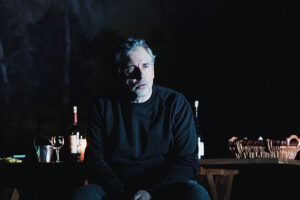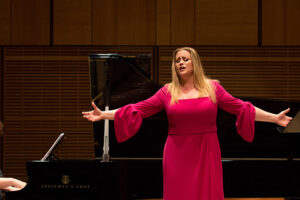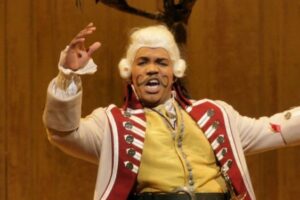

It was one of my first concerts in my new home town, and a thrilling night—Carol Vaness (Tosca), Giuseppe Giacomini (Cavaradossi), and Giorgio Zancanaro (Scarpia) were in peak form in roles for which they had the requisite heft and color, and Maestro Riccardo Muti conducted as one to the manner born. That was a conventional concert performance – the singers in evening dress, standing in front of the orchestra—yet full of theatrical electricity.
This time, the Philly Orchestra’sTosca—featuring Jennifer Rowley (subbing for the indisposed Sonya Yoncheva) in the title role, Yusif Eyvazov as Cavaradossi, and Ambrogio Maestri as Scarpia—was “semi-staged,” with much of the action set on a smallish platform, behind and high above the orchestra. Rows of empty seats were visible behind them, and at moments it looked like Puccini’s hammer-and-tongs melodrama had been mashed up with Annie Baker’s The Flick.
In both cases, their configurations—Muti’s cast front-and-center; Yannick’s recessed and apart—proved suitable metaphors for the performances as a whole.
There was indeed a star this time around, in the sense of a collective protagonist—the orchestra and its maestro. Their playing was ravishing, glittery with articulated coloristic details that one rarely hears in the opera house. Nézet-Séguin has some interesting ideas about the score.
Some tempi were quite fast (the very opening, for example); others drawn out (“Vissi d’arte”), sometimes astonishingly so. The Act III prelude and into “E lucevan le stelle” were some of the best moments, infused with melancholy grandeur in shape and color. Yannick’s Toscaas yet feels like a work-in-progress—the sense of a continuum, of Toscaas a whole dramatic arc yet to be realized—but the pleasure of individual episodes was considerable.
Would that the same could be said about the semi-staging! Instead, it was awkward and often silly, the blocking reduced to basics. With a limited playing space, stairs and aisles were used for entrances and exits, allowing little sense of dramatic surprise.
The show became a kind of picture flip-book Tosca, with a few iconic poses (Tosca discovering the knife, for example) but none of the detailed surrounding business (Tosca and Scarpia actually at a dinner table) that would provide grounding and context.
The traditional costuming was unattractive and largely unflattering. A few moments—Scarpia (the exceptionally tall Maestri) rising from the dead to sneak out behind a blanket; the shepherd boy sporting tiny wings; a slide show designed to pull focus from poor Tosca, stuck on a balcony with no place to leap—edged into camp.
Worse still—the placement of the staging area proved problematic acoustically, making the voices sound distant and poorly integrated with the fulsome sound the orchestra was producing.
Keeping all that in mind, I’m inclined to think none of the principal singers was ideally showcased here. Here goes…
Eyvazov (Cavaradossi): In terms of vocal size and ping, his penetrating, focused tenor is the closest match of singer and role. That said, it’s a curiously uneven performance.
“E lucevan le stelle” is clearly his moment, drawn out but still within the boundaries of taste, the long lines managed cleanly, and some truly lovely singing at mezzo-forte. Earlier on, the voice sounded throaty. Eyvazov tends to bellow, and his Italian isn’t always clear. He’s not much of an actor, but that’s preferable to overdoing it, and I found his simple, open emotionality quite appealing.
Maestri (Scarpia). The pleasure of native Italian pronunciation, every word clearly registering meaning, was a joy. Maestri was most effective in the quiet parlando passages, which truly sound conversational. It’s not quite the right instrument for Scarpia, which wants more tonal density especially at the top, and a sound it “speaks” more quickly.
But Maestri is an artist and a clever actor—given his imposing physical stature, he’s smart enough to keep gestures to a minimum. As a theatrical performance, Maestri’s was the most successful of the evening.
Beyond the staging, Rowley had the additional disadvantage of being brought in late. Still, her performance was disappointing in almost every way. It’s an attractive voice, with some sheen in the upper range as well as a biting chest register… and maybe in a small theater, Tosca would work.
Here, though, her vibrato tended to blur phrases and pitches, she didn’t project well vocally, and the words (even in “Vissi d’arte”!) were rarely clear. Her dramatic conception of the role is kittenish and arch—we can believe this Tosca is a minor singer with an outsized ego. But we can’t see her as a great diva; even less, as a desperate woman in a tragic situation.
Among the supporting cast, Richard Bernstein (Angelotti) and André Courville (the jailor) brought dark, dense baritone voices and stage gravitas, while Kevin Burdette schticked-up the Sacristan like a children’s birthday party clown.
Again, probably best to give everybody the benefit of the doubt here. A more straightforward concert staging would have been greatly preferable all around, not least because the singers would have the freedom to present their best selves. I’m no whiz with calculations and figures, but I can tell you this much: “semi-staging” delivers less theater than no staging at all.
Photo: Jessica Griffin/Philadelphia Orchestra























Comments